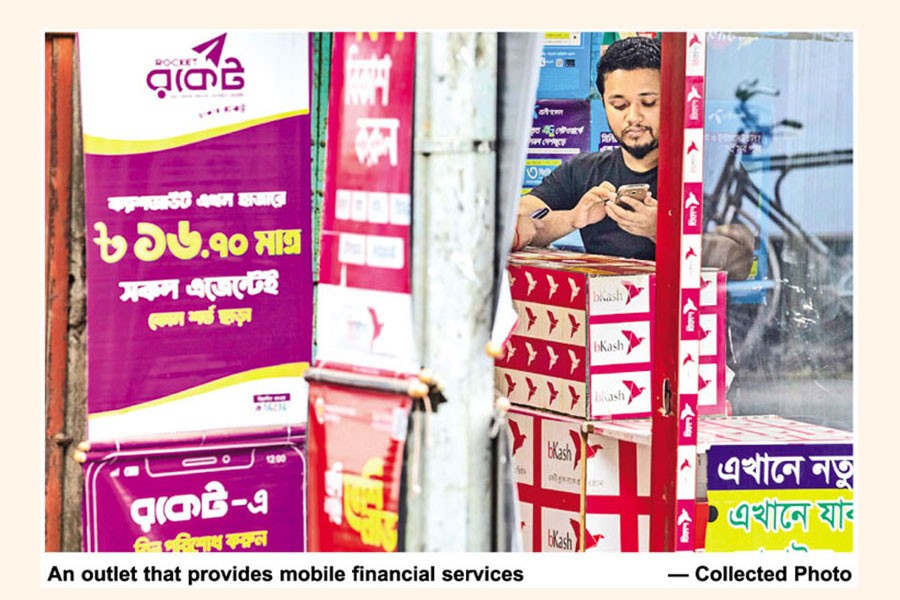
 Arguably, financial inclusion has been one of the most-discussed topics in Bangladesh for the last one and a half decades. The objective was equitable and sustainable socioeconomic growth, one that would leave no one behind. Initially, the concept comprehended the course of including as many citizens of the country as possible in the formal financial or banking sectors through different means, like more branches of scheduled banks in rural areas, special needs-oriented services (for farmers, SMEs etc), insurance schemes, and Mobile Financial Services (MFS).
Arguably, financial inclusion has been one of the most-discussed topics in Bangladesh for the last one and a half decades. The objective was equitable and sustainable socioeconomic growth, one that would leave no one behind. Initially, the concept comprehended the course of including as many citizens of the country as possible in the formal financial or banking sectors through different means, like more branches of scheduled banks in rural areas, special needs-oriented services (for farmers, SMEs etc), insurance schemes, and Mobile Financial Services (MFS).
The preliminary steps prioritised identifying large deprived or marginalised groups with potential future contributions who necessitated specific policy interventions to make them inclusive of the formal financial sectors. Later, small-pocket groups were also accounted for eventually to promote and expand the idea of inclusiveness.
The United Nations Sustainable Development Goals (SDGs) identify and the World Bank (WB) confirms financial inclusion as a key driver of a country's sustainable economic growth as it ensures access to useful and affordable financial products and services for individual and organisational entities in the form of transactions, payments, savings, credit and insurance.
According to the WB, 53.0 per cent of individuals in Bangladesh are included in the formal financial infrastructure. Considering the number of bank accounts and credit cards, it is around 20.0 per cent. The rest are sole contributions of the MFS. Collectively, MFS operators transact an average of Tk 3,500 crore on a daily basis.
According to Bangladesh Bank (BB), the number of agents and outlets reached 12,345 and 16,421, respectively, and the total accounts reached 11,022,646 (544,536 in December 2016) as of March 2021. Among those accounts, more than 53.0 per cent are male holders, 46 per cent female, and less than 1.0 per cent are institutions. The COVID period has shown how this inclusion can keep the heartbeat of an economy going while working as a catalyst with interventions and stimulations.
The wide network of branch banking, agent banking, and MFS has contributed to the continuation of economic activities and the dissemination of support packages. But, despite all this, according to the WB, Bangladesh still remains one of the 25 countries wherein 73.0 per cent of the world's financially excluded people live. Also, the country is way behind in catchup when it comes to financial security through inclusion. Insurance products/ schemes for individuals and firms with tailored features and benefits have yet to be familiarised here.
Now is a time of crisis, and the media is on a frantic journey for its time. Evidently, Bangladesh has been at the door of the IMF alongside its austerity measures like restricting power- and foreign-currency usage and fuel rationing. Ongoing debates are covering lots of areas where discrepancies with megaprojects and the energy sector, non-performing loans (NPLs), and capital flight are leading the board.
Even there are the Russia-Ukraine war and global recession - growing trade deficit, shrinking foreign reserves, depreciating local currency, increasing inflation, and intensifying energy crisis are not just months' worth of damage to the economy as a whole, and that is reflected in the public discussions in different domains. So, why discuss financial inclusion now? Why is it relevant at moments like this when significant end identifiers are significantly decreasing export income, remittance, and aid disbursement?
Forecasting the kinds of crisis for countries like Bangladesh earlier this year, the IMF had suggested acting on COVID recovery, tackling inflation, and addressing debt scenarios. The IMF urged the central banks to take the lead on the policy responses while prioritising safety nets, health, and education and targeting the most vulnerable. Also, it is evident that a crisis imposes structural change. And it is imperative that the country should take advantage of the structural changes to accelerate the redistribution of resources from poorly managed activities to those that offer the largest longer-term economic and social benefits.
To achieve those, fostering innovation through promoting entrepreneurship, investing in smart infrastructure, accelerating activities for which barriers may have been too high otherwise etc can be important mediums, most of which are externalities of higher financial inclusion.
Research has shown that households and businesses having access to financial services are better at withstanding financial shocks than those that don't have. In Bangladesh, very poor rural households received higher urban-to-rural remittance payments when they had a mobile money account, so they were able to reduce borrowing and were less likely to experience extreme poverty.
Another study found that workers who received their wages through direct deposit saved more than workers who were paid in cash. Moreover, digitising government payments can reduce administrative costs and are more likely to reach the intended beneficiaries.
Women having access to bank accounts, savings mechanisms, and other financial services are more likely to raise their productivity and earnings and reduce their chances of being poor. And, with the current gender ratio of the country being 99 according to the 'Population and Housing Census 2022,' the gender effect of financial inclusion is now expected to be much higher than ever.
Even only if the marginalised and most vulnerable groups are considered, the externalities and multiplier effects of financial inclusion as a sustainable formalised system will ensure equitable growth in a protected environment. However, forecasting the upstream socio-technological shifts in social inclusion and digital inclusion must accompany the idea of invigorating 'digital financial inclusion.'
With increasingly dominant 55.58 million internet users in 2022 (11.6 per cent more than in 2021), the country's top-down and supply-centric ICT policies are not complementary to its vision. Therefore, citizen-centric and pro-poor policies to promote IT and ITES in the financial sector can come utile at the moment.
To supplement these, the reduction in transaction costs and digital skills and financial literacy-based approaches are to be focused on as catalysts for change. Now, these policies, instrumental activities, and approaches will not readily contribute to untangling the present crisis but will prevent shocks-enabled consequences from averting future ones.
Omar Khayum is a researcher at the Centre for Peace and Justice (CPJ), Brac University. Views expressed in this article are of the author's and do not necessarily reflect the position of Brac University.
hmomarkhayum@gmail.com
© 2025 - All Rights with The Financial Express
